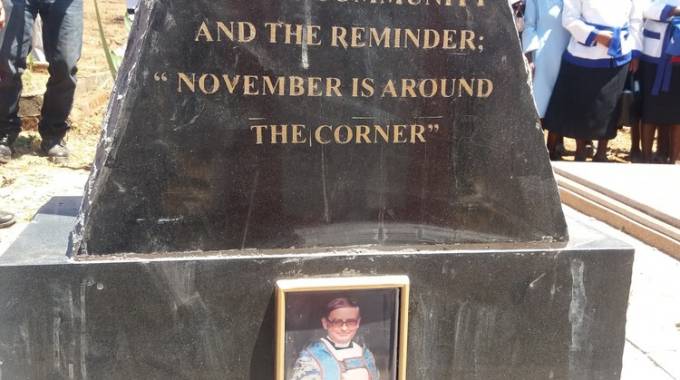
The ManicaPost

Morris Mtisi
CAN a white man be a hero of our liberation struggle?
The answer is certainly “yes”! Are there any white unsung heroes in the annals of our Zimbabwean armed struggle? The answer is, “quite a few!” There is no better time in the political development of our colour-blind country characterised and driven by a new dispensation, to recognise even white unsung heroes. Because they were there with us in the trenches, one way or another!
Yes, Rhodesia, like its neighbour South Africa, was heavily infected with Apartheid . . . a discrimination leprosy that made whites believe they were superior to blacks in every sense of life. But there were a few whites who not only supported the cause of black majority rule, but practically suffered with them and literally put their careers and lives on the line. One of these heroes was Community of the Resurrection (CR) Father Kebble Prosser.
The CR clergyman spent the prime part of his life at St Augustine’s Mission, a historical church school monument that soon became a beacon of academic excellence in the country.
Established by his kinsmen who came before him, this is the school that Zimbabwean armed struggle luminaries like Herbert Chitepo went to.
Back in Mozambique freedom fighters undergoing military training, a lot of them who left St Augustine’s High School to join the war of liberation, knew there was a white CR father at the Mission; a father who supported the armed struggle whole heartedly and in every sense.
St Augustine’s was literally a base-camp in the front where supplies of food, clothing, medicine and other needs were guaranteed. This put the school at risk everyday of the armed struggle and put Father Prosser’s life on the line.
He however, supported the struggle to the bitter end.
At the height of the war of liberation, a time came when literally all schools in Zimbabwe closed. What dramatic irony! One would think Tsambe would be the first to close with a war-collaborator like Father Prosser at its helm.
It did not close.
The brave Anglican Father would have the closure of this school over his dead body. The reason was not only because of the love for his “children” he did not want to lose an education.
At the back of his mind, Father Prosser knew that if the school closed even the support of the freedom fighters operating around Mutare, Nyanga and Makoni would come to a standstill and weaken the onslaught of guerrilla activities in the areas.
Father Prosser left Tsambe for the UK, his homeland in 1990, but requested to be brought back to be buried at St Augustine’s Mission when he died.
In the cemetery where on August 5, 1979 during the war, he had interred Tendai Pfepferere’s body . . . and many more local community members.
He was the Priest-in-Charge.
True to his word and wish, the late Fr Prosser’s ashes were brought back to Tsambe for burial in November 2015. Those who loved the Man of God felt deeply honoured for this gesture. His ashes were interred close to the tomb where on July 6, 1979 he had buried Tendai Pfepferere’s remains.
Today, the two heroes, one black, another white, lay side by side, hardly three metres apart as if everyday saying to each other, “Here we are brother! We were in it together. May our spirits everyday speak love, selflessness and living for other people,” to the entire Tsambe community.
The Tsambe Institutional Memorial Project is a vision of and by the people who genuinely regard these two as real liberation war heroes. The two rightly deserve a chapter in the annals of this great national and monumental institution — St Augustine’s.
The memorial college is part of our Zimbabwean heritage wealth that must be recorded and kept for generations to come, to benefit from, remember and cherish.
The Tsambe Memorial College shall be a three-legged idea. It shall run or operate three separate projects in one. The first leg is the shooting of a feature film called “They shot my brother” (ref the cold murder of Cde Pfepferere by the Rhodesian army). The second is building an Arts Skills Development College or Institution on St Augustine’s Mission farmland.
The third is to spearhead a huge behavioural transformation or moral rearmament movement called Girls of Substance, which is intended to complement Ministry of Primary and Secondary Education’s efforts to address moral decadence in schools, especially institutions of higher learning.
About Tendai Pfepferere: This project speaks of how every Zimbabwean, young and old, must never ever forget that some brave people, particularly youths, bought our Independence with their blood and lives. Pfepferere is an epitome of such courage and selflessness.
This is not a political point. It is a historical point . . . a truth no one can bend or change. We all need to honour these heroes and heroines without fear or favour.
The Zimbabwean present and future both owe it to the past whose and where historical significance is written in the blood of those who fought and died in the war of liberation.
About Father Prosser: This project helps to correct the wrong perception that the war of liberation was a black-versus white conflict and that all whites were enemies of the black-majority rule vision. While this notion might have generally been true, many white men and women of valour stood side by side with the majority of Zimbabwean suffering under the yolk of colonial bondage.
One such a Man of God was Father Kebble Prosser. He ended up an enemy of his own people because he hated what was wrong and stood for colourless God-for-us-all co-existence.



